2.1
NATURAL GAS
Natural gas plays a central role in the energy industry. It is cleaner burning than coal and less expensive than petroleum. In the late twentieth century, the low cost of natural gas made it a very popular fuel for household heating. As a result of the infrastructure built during that time, natural gas has cemented its role as a primary residential fuel. In addition, the limited carbon emissions, operational flexibility, and efficiency provided by natural gas make it a popular fuel for power generation. Almost all of the fossil-fuel-based power plants built in the United States since 1990 can burn natural gas. Consequently, there is a strong link between electricity prices and natural gas prices.
Natural gas was once thought of as an extremely cheap alternative fuel, but this is no longer the case. Long gone are the days when natural gas was burned off as an unwanted waste product of oil drilling. Historically, a prolonged period of low natural gas prices in the 1970s and 1980s led to a construction boom in natural gas infrastructure. Increased consumer demand eventually caused an increase in prices, but the infrastructure still remains. For most municipalities, it would be prohibitively expensive to replace this infrastructure to support another fuel. This makes North America highly dependent upon natural gas for both heating and electricity.
From a physical perspective, natural gas is a nonrenewable fossil fuel used to provide heat and generate electricity. It is a combination of colorless, odorless gases found underground. Natural gas is primarily composed of methane (CH4) but often contains substantial amounts of other hydrocarbons, like ethane (C2H6), propane (C3H8), and butane (C4H10). Natural gas is considered “dry” when it is almost pure methane, and “wet” when it contains substantial quantities of the other hydrocarbons. It is also common to find natural gas mixed with other nonhydrocarbon gases like nitrogen and carbon dioxide. Because the composition of natural gas varies so widely, it is commonly traded in units of heat energy like British Thermal Units (Btus) or Joules rather than in units of volume (like cubic feet). It is important to know the relationship between energy content and volume for dry gas.
• There are approximately 1,000 Btus per cubic foot of dry natural gas.
• There are approximately 1 million MMBtus (million Btus) in 1 Bcf (billion cubic feet) of natural gas.
• For consumers, natural gas is typically sold in therms. A therm is 100,000 Btus or one-tenth of an MMBtu.
Natural gas is most commonly transported through pipelines. Some of these pipelines are transcontinental in length while others span a single town. Transcontinental pipelines move natural gas from producing regions to consuming regions. Local pipelines deliver gas to consumers in a limited geographical area. Pipelines are used because the primary component of natural gas, methane, contains a relatively low amount of energy per volume. Longer chain hydrocarbons like propane or butane contain enough heat energy that it is practical to transport them in pressurized metal containers. However, since methane requires a much larger storage container to hold the same amount of heat energy, and since it is impractical to use very large pressurized containers, natural gas is instead transported by pipeline.
Natural gas can also be transported in liquid form. To turn natural gas into a liquid, it must be supercooled to −263°F. This process is called liquefaction. However, since most consumers lack the specialized equipment to handle supercold liquid gas, natural gas is almost always returned to gaseous form before it is delivered to customers through the local distribution pipelines. The biggest advantage of liquefaction is that liquids are much denser than gases. Because of this, they will contain substantially more heat energy per unit of volume. Transporting natural gas as a liquid avoids the logistical problem of keeping the gas stored in an extremely large high pressure container for an extended period. Liquefied natural gas is used primarily for long-distance transportation of natural gas over oceans where building a pipeline is impractical. Sometimes it is also used for storage.
Major Market Participants
There are a wide range of businesses associated with extracting natural gas from the ground and delivering it to customers. Exploration companies search for natural gas reserves underground. Drilling companies extract the natural gas from the ground and transport it to a processing facility. At the processing plant, impurities are removed from the raw natural gas as it is separated into its component hydrocarbon gases. Then, the dry natural gas (methane) needs to be transported to customers. Natural gas is transported by interstate pipelines or tanker ship. After it arrives in the consuming region, it must be stored until a consumer is ready to take delivery of the natural gas. Finally, when the customer turns on his or her gas, it needs to be delivered by a natural gas distribution pipeline.
Most of the companies on the physical side of the natural gas business specialize in one or two of these areas. Each area of natural gas production is relatively complicated, and it is hard to be equally good at every job. Moreover, the skills necessary for running physical businesses are very different than the skills used for speculating on financial commodities. The job of trading of natural gas is left to natural gas marketers.
Natural gas marketers buy and sell natural gas. They are speculators and investors who want exposure to the trading markets. Often these are Wall Street firms or spin-offs from integrated energy companies. Occasionally, they are branches of a service company. Trading does not show the steadily increasing, safe profits desired by the stockholders of a service-based organization. Because of this, many natural gas services companies no longer maintain large trading desks. They don’t want to run the risk that an otherwise strong company will be destroyed by a couple of bad trades.
There are no hard rules preventing the physical businesses from being gas marketers. Many marketers started out associated with a physical company, and most physical companies still maintain a trading desk after they leave the marketing business. For example, physical companies often need to execute trades to eliminate the price risk of holding raw materials. Even the most conservative firms will occasionally make some speculative trades. Because of their expertize in a specific area, a specialist company can often recognize investment opportunities before other market participants. However, as a general rule, the goal of most physical natural gas companies is to make their profits in a hard-to-enter market niche and leave the speculation to other people.
There is a lot of specialized knowledge required to be a gas marketer. Marketers handle much of the paperwork that ties the various parts of the energy industry together. In the natural gas world, marketers do this by arranging for storage and transportation of natural gas. They have to handle the relationships, legal agreements, and processing necessary for trading with a variety of different businesses in multiple markets. Typically, this requires an extensive operations and legal teams. Marketers also need to have contractual agreements with everyone they trade with and continually monitor their creditworthiness. Because having a large number of industry contacts is a business necessity for marketers, they tend to have a wider focus than the physical companies. Marketers typically trade a wide variety of commodities like electricity, coal, oil, and emissions credits.
Exploration and Extraction
Natural gas is commonly found dissolved in oil fields, coal beds, and underground rock formations. It is produced from decaying organic materials located in areas where the gases can’t disperse. In nature, this commonly happens when organic material is caught between layers of impermeable rock. In nature, natural gas deposits can be millions of years old. However, natural gas can also be created by decomposing organic materials like the plants and animal wastes found in modern garbage dumps.
When organic material decomposes, methane is a common byproduct. Most of the time, this methane disperses into the atmosphere. However, when an impermeable material prevents the gas from dispersing, it can become trapped underground and later extracted. Most commonly, when gas is trapped underground, it is not located in a large open cave. Instead, gas is forced into small holes in the rock, and disperses in the rock layer surrounding the decaying material (Figure 2.1.1).

Figure 2.1.1 Formation of natural gas
If the rock layer trapping the methane has the right physical properties, it is possible to remove the gas by drilling through the impermeable layer of rock. Typically, exploration companies look for a permeable layer of rock located underneath an impermeable layer of rock. In order to extract the natural gas from where it is trapped, the methane has to be able to flow toward the well (Figure 2.1.2).

Figure 2.1.2 Natural gas drilling
Porous, permeable rock is the best type of rock for storing natural gas. This type of rock has lots of small, connected holes that allow a substantial amount of gas to be removed. The pores are small holes in the rock. It is necessary for rock formations to contain enough storage space to have an economically significant amount of gas in one area. It is also necessary for the pores in the rock to be connected to each other. Otherwise, the gas can’t flow between the holes in the rock, and only the gas near the exit pipe will be removed. The physical characteristics of the rock forming a gas reservoir have a direct impact on the speed with which natural gas can be recovered from the ground.
In addition, the performance of natural gas wells is determined by the pressure of the gas in the well. Gases move from areas of high pressure to areas of low pressure. In conjunction with the natural tendency of a gas to rise, placing a vacuum at the mouth of a reservoir will pull the gas upward. The speed of this upward movement depends on the pressure of the gas in the reservoir. When it is first removed, the gas is at its highest pressure and will move quickly upward. As gas exits the reservoir, the pressure will decrease, and it will exit more slowly. Eventually, there will no longer be an economically significant amount of gas leaving the reservoir and the well will be closed. This process can be sped up by injecting water into the well. Since methane doesn’t dissolve in water, this will increase the pressure of any remaining gas.
Hydraulic fracturing (fracking) is a way to remove natural gas from porous, impermeable rock formations. Porous, impermeable rock can be made permeable by creating microfractures throughout a rock formation. The most common way to create fractures in rock is to inject water or similar hydraulic fluid into a rock formation and create compression waves using controlled explosions. This allows the natural gas to be removed using conventional drilling techniques.
Processing
Because natural gas is not pure methane when it comes out of the ground, it is necessary to bring it up to a consistent standard quality. All of the particulate matter and liquid water in the gas have to be removed to prevent damage to pipelines and consumer equipment. Trace pollutants like hydrogen sulfide and mercury have to be removed. The gas needs to meet a standard for energy per unit volume. For example, in North America, the heat energy of natural gas sold to consumers needs to be in the range of 1,035 Btu ± 5 percent per cubic foot at standard temperature and pressure.
Larger hydrocarbons, like propane and butane, turn into liquids at a warmer temperature than smaller hydrocarbons like methane. As a result, they need to be removed from the natural gas to prevent liquid from building up in a pipeline. Engineers utilize the different dew points of hydrocarbons to separate combined gases. The primary way of separating a combined gas into individual gases is to progressively cool the combined gas until it reaches a temperature where the larger chain molecules turn into liquids. At that temperature, the smaller molecules remain a gas, and the liquids can be siphoned off to leave only the simpler hydrocarbon gases. This process can be repeated a number of times to remove multiple hydrocarbons.
Pipeline Transportation
Natural gas is most commonly transported through pipelines. As mentioned before, the main problem with transporting natural gas is its low energy density. Methane is the simplest hydrocarbon gas and contains less energy per volume than more complex hydrocarbon gases like propane or butane. Pipelines avoid this problem by providing a continuous feed of gas to customers and operating at moderate pressures.
Interstate pipelines make a profit transporting natural gas for customers. These companies straddle the line between public utilities and for-profit businesses. Pipeline services range from guaranteed delivery of gas, the most expensive option, to various degrees of nonguaranteed service. Customers pay different rates depending on their desired level of service. Because pipelines serve an important role as a public utility, the interstate pipeline business is highly regulated and overseen by the Federal Energy Regulatory Commission (FERC). Some of the regulations include limits on new construction, limits on the rates that can be charged, and rules to ensure nondiscriminatory access.
Pipelines are often connected to one another. A natural gas hub is the location where two or more pipelines connect. A citygate is a special type of hub where interstate pipelines connect to local distribution networks. Most natural gas trading occurs at either hubs or citygates. The most important natural gas hub in North America, Henry Hub, is located on the U.S. Gulf Coast about halfway between New Orleans and Houston. Henry Hub is the delivery location for the New York Mercantile Exchange (NYMEX) natural gas futures contract and is used as the benchmark for natural gas sold throughout the United States. The Henry Hub price plays a major role in the energy market—similar to the role played by the S&P 500 Index for U.S. stocks. But, unlike those other indexes, the benchmark for natural gas is not an average—it is actually the price of gas at a single location.
In addition to being an important hub that connects 13 major natural gas pipelines, the Henry Hub is the trading location for NYMEX natural gas futures. It serves as the single most important pricing index in the energy market (Figure 2.1.4).
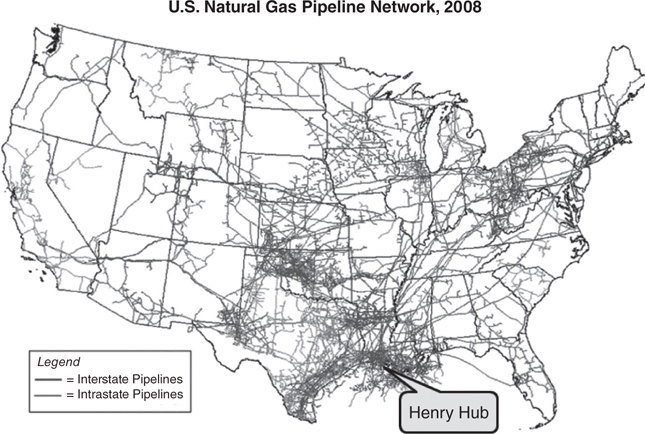
Figure 2.1.4 Natural gas pipeline map
Transportation Contracts
Contracts for natural gas transportation can be firm or interruptible. A firm contract guarantees that the necessary pipeline capacity will be available to transport the natural gas. An interruptible contract will allow transportation whenever customers with firm transportation contracts are not using their full capacity. There are a wide variety of terms used in transportation contracts.
• Reservation Charge. The reservation charge is a fixed monthly charge paid to the pipeline company to reserve transportation capacity.
• Commodity Charge. A commodity charge is the variable cost for transportation. This charge is usually quoted per unit of gas to be transported.
• Annual Cost Adjustment (ACA) Charges. The ACA is a small charge that adjusts transportation costs for inflation.
• Gas Research Institute (GRI) Charges. For U.S. pipelines, the GRI charge is a small fixed charge used to fund a nonprofit industry group, the Gas Research Institute.
• Fuel Usage. Fuel usage describes the amount of natural gas lost in transportation. This lost gas is commonly used as payment in kind to provide power to the compressors responsible for moving the gas.
• Receipt Adder. A receipt adder is a fixed price adjustment used to determine the price at the receipt point relative to the price of a nearby benchmark.
• Delivery Adder. A delivery adder is a fixed price adjustment used to determine the price at the delivery point relative to the price of a nearby benchmark.
• Volume. The quantity of natural gas that can be transported.
Firm transportation agreements are a way to guarantee that space is available on a pipeline. The price of firm transportation contracts is publicly available for any pipeline that qualifies as a regulated utility. The price charged by the pipeline will be listed in a public document, called a tariff, which can be obtained from either the pipeline company or the regulating agency. This will look something like the Pipeline Map and Tariff Schedule in Figure 2.1.5.
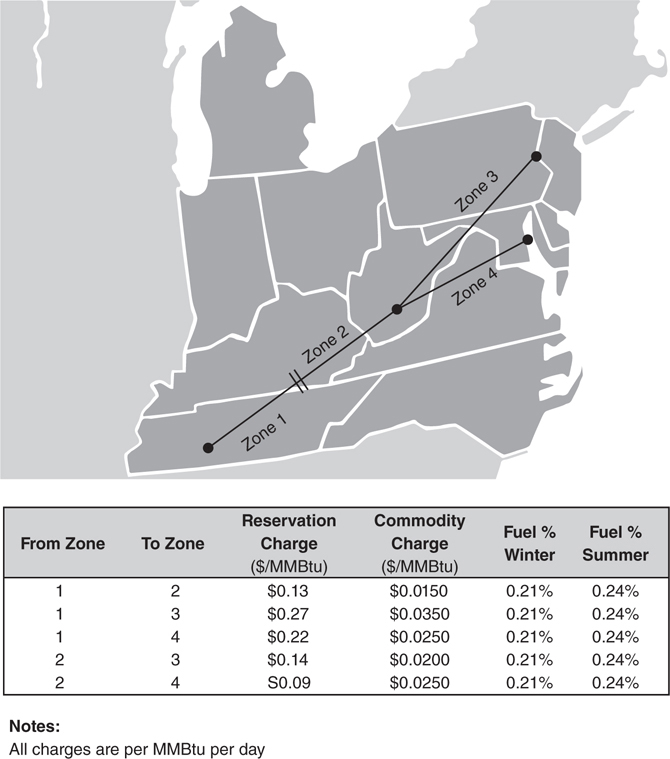
Figure 2.1.5 Pipeline map and tariff schedule
Interruptible transport can also be obtained from most pipelines. This type of contract allows use of the pipeline whenever space is available at a price negotiated with the pipeline. For example, a pipeline might have a natural gas fired electrical generator as a firm transportation customer. The generator might use their pipeline capacity only during especially hot or cold periods. The pipeline could resell the unused capacity to other market participants. For example, a storage facility might buy interruptible transportation. That business model might be to buy gas to fill their facility when few people are using the pipeline and sell gas out of their facility when usage is high.
Transportation costs are commonly quoted by the cost to move gas from one zone to another zone. However, not all pipelines are separated into zones. Some pipelines are considered a single zone and there is a fixed cost, called a postage stamp rate, to transport natural gas anywhere on that pipeline.
• Zone Rates. Areas of pipeline are commonly divided into zones. The pipeline tariff for these pipelines would list the cost to transfer gas between zones.
• Postage Stamp Rates. Some pipelines have a single zone. In that case, a postage stamp rate is the cost to transport gas anywhere on the pipeline.
Liquefied Natural Gas
The second way to move large quantities of natural gas is to convert it into a liquid and transport it on a ship. To liquefy natural gas, it is necessary to lower its temperature to –263°F (–160°C). As a liquid, natural gas takes only 1/610 of the space that it occupies as a gas. Unfortunately, due to the extremely cold temperatures, heavy insulation is required. The insulation needed to keep natural gas cold is usually only cost effective on a large scale (like a tanker ship). After transportation, the gas will need to be heated to convert it back into a gas. There are three main steps in the LNG process: liquefaction, transportation, and regasification.
• Liquefaction and Exporting. To transport natural gas as a liquid, it is necessary to cool the natural gas to –263°F (–160°C). This is a multistage process where sequential cooling units, called a train, progressively cool the natural gas. These plants are usually linked to producing regions by short-range pipelines. In addition to cooling the gas, this process separates out the heavier hydrocarbons. After the gas is cooled into a liquid, it is then transferred to specially designed tanker ships.
• Transportation. Once the LNG is loaded aboard ship, it is transported to an intermediate destination called a regasification facility. LNG transportation ships have to be specifically designed to handle extremely cold liquids and keep them well insulated. However, even in the best insulated ships, some liquid methane will convert back into a gas and be lost in transportation. Larger scale transports, faster travel time, and cryogenic cooling systems to refreeze the boiled-off gas can reduce these losses.
• Regasification and Importing. After transportation, natural gas is heated to return it to gaseous form and processed to meet local pipeline standards. Then, the gas is ready to be injected into a pipeline to travel to its final destination.
Basis Prices
The terminology for natural gas trading is different than other financial markets. When natural gas prices are quoted by a trader, the quote is usually in relation to the Henry Hub price. This is called a basis price. For example, if the price at the Henry Hub is $3.52 and the price for physical gas at Waha Hub (a trading location in west Texas) is $3.70, the basis price for Waha gas would be $0.18. The term price can refer to either the basis price or the actual price depending on context. For example, if you asked a natural gas trader for the price of gas, he or she would probably assume that you mean the basis price, and quote $0.18. If you asked a utility operator for the price of gas, he or she would assume that you mean the actual price of $3.70. Regardless of the way the price is quoted, the cost to the consumer is the same.
This pricing terminology is a result of how natural gas is traded. Most commonly, natural gas is traded using futures that are priced at the Henry Hub price. The basis price that is quoted by traders is similar to a transportation price to get gas from the Henry Hub to another area. The index price of natural gas is the price at the Henry Hub. The actual price of natural gas, the all-in price, is the combination of the index price and the basis price.
Basis Positions
An actual position means being exposed to the outright price of gas in some location. For example, a trader who owns the gas physically located somewhere is exposed to the actual price. Sometimes, this is called an all-in position.
A basis position means an exposure to a basis price rather than an outright price. Since the basis price is a spread, a basis position is an exposure to two locations—the basis location and the index location. For example, the Waha basis price is the difference between the actual price at Waha Hub minus the index price. Similarly, a long basis position at Waha Hub is like physically owning gas at Waha Hub and being obligated to deliver gas at the Henry Hub (the index location).
How a Pipeline Operates
Pipelines transfer gas by creating an area of high pressure at one end of the pipe and an area of low pressure at the other end of the pipe. For long pipelines, intermediate compressor stations will act like fans to push air through the pipeline. These create low and high pressure zones to keep the gas moving (Figure 2.1.6).
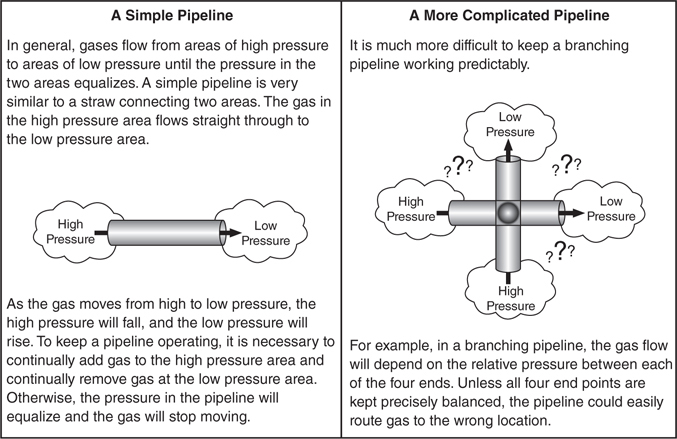
Figure 2.1.6 Pipeline structure
Storage
The operational requirements of pipelines make storing natural gas necessary. Pipelines can’t stop operating. For a pipeline to operate, gas has to be continuously added to one end and removed from the other. Interstate pipelines can be thousands of miles long, and if stopped, might take several days to resume operating at full capacity. As a result, it is impossible for most pipelines to shut down completely. Consumer demand is less constant. Consumers don’t need a steady supply of natural gas around the clock. As a result, it is often necessary to store natural gas at both ends of a pipeline. This provides a cushion to balance the required continuous flow of the pipeline with refinery outputs and variable consumer demand. Natural gas is stored at the start of a pipeline to prevent interruptions at gas refineries from disrupting the pipeline. Gas is stored at the end of a pipeline to help match up the continually flowing pipeline to consumer demand.
As mentioned earlier, in gaseous form, natural gas isn’t very energy dense—it takes a very large reservoir to store a significant quantity of heating energy. In general, it isn’t practical to build a large enough storage container above ground. As a result, in gaseous form, natural gas is typically stored in underground reservoirs. If natural gas is stored above ground, it is usually liquefied and stored in an insulated container rather than as a pressurized gas.
There are a limited number of sites around North America that can be used to store natural gas (Figure 2.1.7). Natural gas storage requires large reservoirs located in the right area. Storage reservoirs are most commonly located close to refineries, at hubs that connect major pipelines, or close to where the gas will ultimately be used. Another consideration is that the size of the reservoir needs to be large enough to make it cost-effective to hook it up to a pipeline. Pipelines get harder to coordinate when they have lots of connections. Additionally, much of the cost of storing natural gas is due to the equipment to pump gas into the storage facility. This same equipment is required for both large and small facilities, and small facilities lack the volume for a reasonable economy of scale. As a result, there are only about 400 natural gas storage facilities around the country.

Figure 2.1.7 Natural gas storage facilities
Distribution
Most customers don’t receive gas directly from the interstate pipelines. Typically, gas is delivered to consumers by a local distribution company. These distribution companies maintain an extensive network of small pipes throughout each regional distribution area. These local delivery networks are substantially different from the interstate pipelines. Local distribution networks have to maintain connections to every home and business regardless of the economic profitability of each connection.
As a result, local distribution networks are very expensive to maintain. Local delivery charges account for a large portion of the retail price of natural gas. On utility bills, the cost that most customers pay for their natural gas will be a combination of the citygate price (the price of the gas delivered to the local utility from an interstate pipeline) and a local delivery charge. Commonly, these delivery charges make up about half the total retail cost of natural gas.
Trading and Marketing
There are several common types of natural gas trades. The simplest trade is a directional bet on the entire natural gas market. For example, that the market is going to go up or down in price. However, since natural gas prices are cyclical, it is more common for traders to try to speculate on one aspect of the natural gas market by entering into spread trades.
A spread trade is any trade where a trader benefits from the price difference between two securities by buying one security and selling another. These trades are popular; they eliminate a trader’s exposure to the entire market moving up and down.
• Location Spreads. One common type of trade speculates on the price difference between two locations. Depending on demand, natural gas prices can be substantially different between two different locations. Natural gas transportation is not instantaneous, and storage is often limited. In periods of peak demand, some areas will have a greater demand for gas than can be supplied through the pipeline or storage facilities. The price of gas in those regions will rise until more supply can be brought in. In other cases, a period of moderate weather might decrease demand, creating a supply glut, and cause prices to plummet.
• Heat Rates. Another common trade is to speculate on the relationship between natural gas prices and electricity prices. In general, the price of electricity closely mirrors natural gas prices. Using a power plant, it is possible to turn natural gas into electricity. This keeps natural gas and electrical prices linked together most of the time. However, since two very different mechanisms are used to determine the prices of power and natural gas, they don’t move together all of the time and it is possible for a trader to benefit from that volatility.
• Time Spreads. Spread trades can exist between two time periods as well. This type of spread trade speculates on the price difference between periods of high and low demand. For example, it might be possible to speculate on a colder than normal winter by betting that gas prices will be high. The trader might buy winter gas and sell spring gas to eliminate directional exposure to the entire market.
• Swing Trades. A similar type of trade relies on the physical ability of the trader to store natural gas over short periods. Pipelines must operate around the clock. However, demand for gas varies considerably even over short time periods like a week. For example, a lot of gas is used on Monday mornings to restart industrial facilities and reheat offices after the weekend. Comparatively less gas is used late at night on Saturday because there is no industrial demand and houses are less heated after people are asleep. As a result, it is often possible to pick up inexpensive natural gas when demand is low and resell it when demand is high. This requires the ability to store the natural gas.
Spot and Forward Markets
Like many other energy products, the forward and spot markets for natural gas are distinct from one another. Spot markets involve buying gas for immediate delivery. Forward markets involve buying gas for delivery sometime in the future. These markets are separate because gas production, transportation, and storage have to be arranged ahead of time.
If there is a shortage in natural gas expected in a couple of weeks, it is usually possible to increase production and bring in more supply. However, if there were a shortage today, there is no real way to get more supply immediately. It is difficult to move a large quantity of gas into or out of storage quickly or transfer in supplies from nearby areas on short notice. In the forward markets, prices are determined by macroeconomic issues—the expected average relationship of supply and demand in the future. In the spot market, prices are based on the supply that is on hand right now and consumer demand right now. As a result, the spot markets are substantially more volatile than the forward markets.
In markets where spot and forward commodity markets are linked, usually there is a constant amount of the commodity, and it isn’t consumed when it is used. The spot and forward markets for those products are linked by the ability to buy the commodity in the spot market and store it for future delivery. Since the commodity is never used up (like a gold bar or a stock certificate), those assets aren’t affected by short-term fluctuations in supply and demand. Natural gas does not work the same way. A continuous supply of new natural gas is constantly required, consumer demand changes constantly, and it is difficult to store and transport.
Long-term buy-and-hold strategies are of limited use in natural gas trading. Gas has no intrinsic value by itself—it is the products created by burning natural gas that are valuable (heat or electricity). Moreover, gas in storage is no easier to deliver than gas newly extracted from the ground unless the storage is located near a consuming area. In fact, the most common storage facilities are actually previously emptied gas wells. As a result, buy-and-hold strategies are essentially the purchase of undeveloped gas reserves. Traders use storage facilities to balance supply and demand for periods less than a year. For example, traders might buy gas in the summer to sell during the next winter, but they aren’t going to buy gas and hold it for several years as a long-term investment.
That doesn’t mean there isn’t a spot/forward relationship in forward natural gas prices. However, this relationship is more complicated and less reliable than in other markets.
Swing Swaps and Options
In addition to standard derivatives like futures, forwards, and options that deliver over an entire month, the natural gas market has derivatives with daily delivery called swing swaps and swing options. These trades are often used by utilities to manage volumetric risk—the risk that the consumers served by the utility will use more gas than expected. For example, a utility that can’t pass through higher costs to consumers might wish to protect itself from the risk of a winter cold front that causes consumers to use more gas than expected.
• Swing Swap. These swaps will exchange a fixed price determined at the start of the delivery month for the daily spot price reported by some pricing service.
• Swing Options. These options will give the buyer the right to purchase some quantity of gas at a price determined at the start of the delivery month (usually by referencing a publication like the Platts Inside FERC1, or IFERC, survey) at any time during the delivery month. These options typically have a limit on how many times gas can be purchased.
Swing swaps and options differ from standard swaps and options because the fixed price is determined at the start of the delivery month rather than negotiated during the transaction. The most common type of price used in these contracts is the prevailing price reported by various surveys at the start of the delivery month. The Platts Inside FERC survey is the most well-known survey of this type. However, a variety of market data providers provide bidweek reports that have comparable information.
Forward Prices
Looking at the forward market, prices are determined by seasonal expectations of supply and demand rather than on the current spot price and storage costs. Seasonal expectations of supply and demand are generally the same every year. Consequently, prices in the forward market tend to mirror consumer demand—both are high in the winter and fall dramatically in the spring of every year (Figure 2.1.8).

Figure 2.1.8 Natural gas forward curve
Natural gas forward prices are highly cyclical without the smooth upward slope in prices observed with storable commodities. Compared to other markets where forward prices are determined by interest rates and storage costs, this is a very different relationship.
Price Certainty
The price of natural gas becomes less certain close to delivery (Figure 2.1.9) than further away. This is very different than most other markets. This is because short-term disruptions to natural gas supplies have a big effect on prices. However, unless prices change for a lasting fundamental reason, large price movements in the spot market do not have a large effect on future prices. Forward prices tend to revert to prices based on typical consumer demand and expected supplies (Figure 2.1.9). Prices are more volatile in the spot price than in the forward markets.

Figure 2.1.9 Volatility of nearby natural gas futures contracts
Spot Prices
Spot prices do not show the same seasonality as future prices. While forward prices have a very regular, seasonal trend, spot prices are all over the place. This is because spot prices are based on short-term supply and demand issues. Looking at spot prices, they are very different from the highly predictable prices in the forward market (Figure 2.1.10).

Figure 2.1.10 Natural gas prompt month prices
Part of the reason for this difference is complexity of storing or transporting natural gas on short notice. Natural gas in one location can’t just be exchanged for natural gas in a different location—it has to be physically moved there. If there isn’t enough time to arrange the transportation, there is no longer any linkage between the source and destination locations. Natural gas that needs to be delivered at a specific time has a similar issue. Natural gas requires specialized facilities to store it. If someone doesn’t have access to a storage facility, and most market participants do not, they can’t buy the commodity early for delivery at a later date. The typical natural gas customer is forced to buy natural gas either in the forward market or on the spot market on the day the gas will be used. They can’t buy a supply of gas when it is cheap on the spot market and store it until it is needed.
There are two major effects of this. First, spot volatility tends to be higher than forward volatility. This effect was illustrated in the discussion of future prices. Second, the spot correlation between two different locations works differently than forward correlations. In the forward market, when it is still possible to arrange gas to be moved from one location to another, most natural gas prices are highly correlated. If they weren’t very similar, it would be possible to shift gas between locations for an easy profit. The only constraints to this trade would be the cost of transporting and storing the natural gas.
In the spot market, none of that is possible. Just as more supply is prevented from coming in, demand is prevented from leaving. There is no way for consumers to shift demand from one area to another easily. For example, it isn’t possible for most homeowners to move to another state for a week if they like the prices better there.
Demand and Weather
On a national basis, the single largest factor affecting demand for natural gas is temperature. During the winter, natural gas is used for heating. In the summer, natural gas is used to fuel electrical generators that are used to supply electricity for air conditioning. The demand for natural gas is lowest in the spring and fall and peaks in the coldest winter months. A graph showing natural gas consumption is shown in Figure 2.1.11.
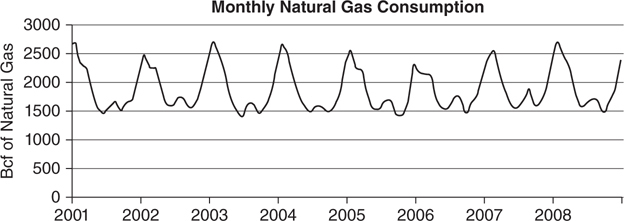
Figure 2.1.11 Seasonal natural gas consumption
Predicting the demand for natural gas is very much an exercise in predicting warm and cold weather. There is a linear relationship between cold temperatures and an increased consumption of natural gas.
Users of Natural Gas
The three largest users of natural gas are industrial clients, residential clients, and power plants. Of the three, the use of natural gas in power plants to produce electricity has risen the most quickly. Most of the power plants built since 1990 depend on natural-gas-fired generators.
• Industrial. Industrial clients commonly use natural gas as a source of heat. Natural gas ignites quickly, and turning off a natural gas furnace doesn’t waste any fuel. A natural gas furnace goes out as soon as the supply of fuel is stopped. In comparison, a coal furnace will continue to burn for a while until the coal in the furnace is fully used. This can result in a lot of wasted fuel if it is necessary to start and restart the furnace multiple times. Manufacturing of metal or glass, cooking, dehumidification, and waste incineration are all examples of industrial uses of natural gas.
• Residential. About half the homes in North America use natural gas for heating. The largest residential use of natural gas is home heating (primarily in the winter). There are a variety of other residential uses for natural gas since it is common for natural gas fueled homes to have several natural gas appliances. Kitchen ranges, hot water heaters, clothes dryers, and outdoor grills are all commonly found throughout the country.
• Electrical Generation. Natural-gas-fired power plants are the fastest growing users of natural gas. Natural gas power plants produce less greenhouse gas emissions than coal or oil based plants. Some natural gas power plants operate year round; others are more seasonal. The seasonal power plants usually turn off in the winter when the price of natural gas is at its peak.
The western U.S. is separated from the rest of the country by the Rocky Mountains. (Figures 2.1.12 and 2.1.13).

Figure 2.1.12 Major trading locations. Map courtesy of FERC.

Figure 2.1.13 Supply and demand
• Electrical generators throughout the entire area depend on natural gas as a primary fuel. The southern part of the West Coast has very hot summers, and natural gas is especially in demand during those periods to provide electricity for air conditioning. The major competing power source is hydroelectric power from the Pacific Northwest. As a result, precipitation and snowmelt can have a large effect on regional natural gas prices during peak demand periods. Most of the region has mild winters.
• In the western United States, the geography is dominated by the Rocky Mountains. The West Coast (Washington, Oregon, and California) and parts of Arizona are heavily populated. However, most of the region has a sparse population. California is the biggest user of natural gas, and trading commonly revolves around imports to the California market. These imports come from Canada and the Desert Southwest.
• Storage capacity is extremely limited. This can lead to sharp price movements during periods of peak demand.
• Western basis prices are not highly correlated with NYMEX Futures (Henry Hub) since the region does not directly import natural gas from the Gulf Coast where Henry Hub is located.
• There is a substantial amount of gas produced east of the Rocky Mountains in Wyoming, Utah, and Colorado. However, most of this gas flows to the Midwest rather than to the population centers on the West Coast.
The Midwestern U.S. is an industrialized region with cold winters. (Figures 2.1.14 and 2.1.15).

Figure 2.1.14 Major trading locations. Map courtesy of FERC
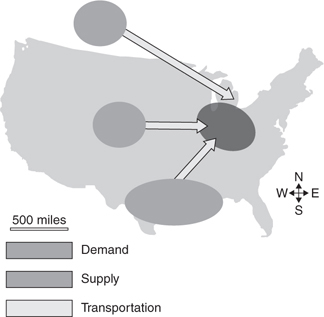
Figure 2.1.15 Supply and demand
• The Midwest is a major consuming region during winter months. Cold winters characterize the entire Midwestern Region and there is a strong seasonal demand for natural gas in the winter to provide residential heating.
• This region does not use natural gas as a primary fuel for electrical power plants. Coal is the primary fuel for power in the Midwestern United States. There is comparatively little demand for natural gas in the summer months.
• Numerous storage facilities and extensive local distribution networks are located in the region. Many of these areas have government-mandated obligations to meet residential demand during winter months. For example, to ensure consumers have access to fuel, governments might force gas in storage facilities to be delivered to residential customers rather than saving it for a commercial use.
• Large pipelines connect the Midwest to all of the major supply basins in North America. Supplies from Canada and the Rocky Mountains supply the bulk of the Midwest’s natural gas requirements. However, some gas also comes from the Gulf Coast Region when it is available.
• Basis prices in the Midwest are somewhat correlated with NYMEX futures (Henry Hub). The region imports gas from the Gulf Coast, but also has access to other gas supplies.
The mid-Atlantic to northern part of the U.S. East Coast is a heavily populated region. The northernmost area (New England) has very cold winters and limited storage capacity. (Figures 2.1.16 and 2.1.17).
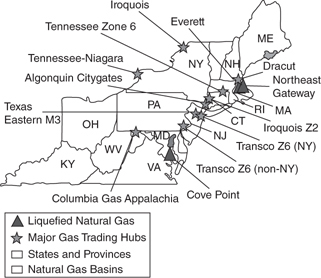
Figure 2.1.16 Major trading locations. Map courtesy of FERC

Figure 2.1.17 Supply and demand
• On the East Coast, natural gas is used extensively for both residential heating and electrical generation. As a result, there is a year-round demand for natural gas in this region.
• There is a limited amount of storage available in the region. Combined with the high seasonal demand for both heating and electricity in the winter, basis prices (prices relative to the supply regions) are often the highest in the country.
• Large shale gas deposits in the Appalachian Region (West Virginia/Pennsylvania border) are providing a large influx of natural gas into the region causing a dramatic reduction in prices during all but the coldest months.
• The East Coast is a heavy importer of natural gas from the Gulf Coast Region.
The Texas/Gulf Coast region is a major producer of natural gas. This region has mild winters and hot summers. (Figures 2.1.18 and 2.1.19).

Figure 2.1.18 Major trading locations. Map courtesy of FERC

Figure 2.1.19 Supply and demand
• The Texas/Gulf Coast Region is a net exporter of natural gas. It is the most important natural-gas-producing region in North America. Most of the exports flow to the East Coast and industrialized Midwest.
• Abundant local supplies have made the region heavily dependent upon natural gas as a fuel for electricity generation.
• The region has mild winters and there is a limited seasonal demand for natural gas during winter months for heating.
• There is a substantial amount of storage in the region. Most of this region’s storage helps exporting pipelines balance supplies of natural gas leaving processing plants to the demand for imports from other areas of the country.
• The basis prices in the region are highly correlated to NYMEX future prices. The settlement location for NYMEX futures, Henry Hub, is located in western Louisiana.
The southeastern U.S. is a rural agricultural region with mild winters and hot summers. (Figures 2.1.20 and 2.1.21).
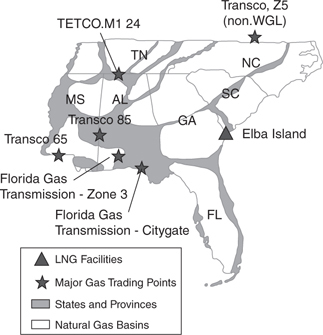
Figure 2.1.20 Major trading locations. Map courtesy of FERC
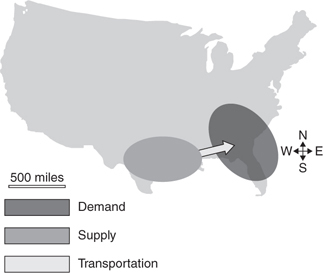
Figure 2.1.21 Supply and demand
• Natural gas is primarily used to provide electricity in the southeastern United States. The demand for electricity peaks during summer months as the hot summers create a high demand for air conditioning.
• Mild winters limit the need for seasonal residential heating.
• The southeastern region has very limited storage capacity.
• LNG terminals are being constructed to export natural gas and provide storage facilities. There is a major LNG terminal at Elba Island.
1 FERC is the U.S. Federal Energy Regulatory Commission.


